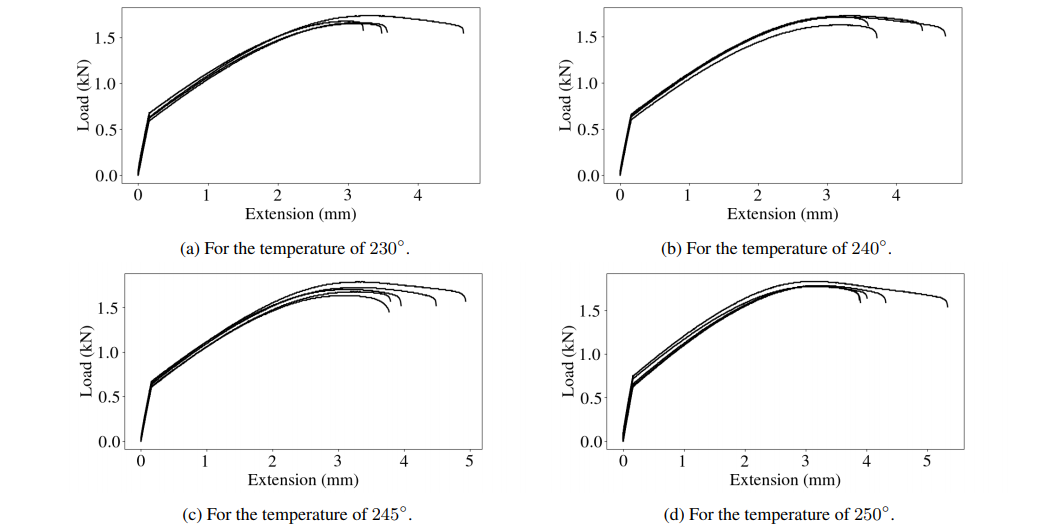Brazilian researchers delve further into FDM 3D printing for prototyping, examining the mechanical properties of and challenges in working with PETG. The results of their study are outlined in ‘Experimental Analysis on the Mechanical Properties of PETG Parts Made with Fused Deposition Modeling Manufacturing.’
3D printing samples on a Prusa i3 MK2S printer, the research team created a new database, upon experimenting with PETG XT filament and a variety of settings and parameters; for example, they worked with several different printing temperatures while 3D printing sample parts which were then evaluated for tensile strength—stressing them to the point of rupture.
Twenty different parts were printed and assessed, and although a variety of printing temperatures were used, the only actual printing parameter that the authors changed was the nozzle temperature. Parts were printed at temperatures ranging from 230◦C to 250◦C, featuring 100 percent infill and longitudinal fabrication.
Upon printing and evaluating samples, the authors compared their results with previous research and literature. 3D models were created with CATIA V5 CAD, and exported 3D files were then sliced in Simplify3D.
Parts were made on a support bed without heat, with the following settings:
- Nozzle diameter of 0.4 mm
- Retraction distance and speed of 5 mm and 2,100 mm/min
- Layer height at 15 mm, with 3 lateral outer layers
- Heated bed set to 80◦C
Five tests were performed for each sample with varying temperatures, with each layer featuring parallel lines, ‘varying 90◦ from one another and made 45◦ with the y axis of the print.’ They noted ‘some regularity,’ although ultimately there was lack of steadiness and ‘notable dissonance’ with each fracture point.

Tensile tests performed on each test part. Five tests for each temperature (each line is an experiment).
“The results were mostly as expected, with the Young’s Modulus increasing with the increase in temperature which happens because the higher temperatures allow for better bonding between each layer of the print,” concluded the researchers. “It is interesting to notice that there is a much greater increase in the Young’s Modulus when the extrusion temperature increased from 245◦C to 250◦C (4.6%) when compared to the increase from 230◦C to 240◦C (0.5%) and from 240◦C to 245◦C (1.8%). The results were close to other test executed in literature as seen in (Szykiendans et al., 2016). But in these tests the overall Young’s modulus was measured around 0.7 GPa. So, the results were slightly higher, possibly because different printing and filament qualities.
“This study shows that higher nozzle temperature results in higher Young’s Modulus. Therefore, when printing mechanical parts where stress resistance is important it is better to print at higher temperatures. On the other hand, if that is not the case, it may be worth it to use lower temperatures to get a better superficial finishing in the printed part, as lower temperatures prevent warping and stringing.”
As researchers around the world continue to refine fabrication techniques for their own uses, mechanical properties are being studied intensely, from further studying of materials like shape memory polymers and 4D printing to improving composites with continuous carbon, and studying the effects of porosity.
What do you think of this news? Let us know your thoughts! Join the discussion of this and other 3D printing topics at 3DPrintBoard.com.
[Source / Images: ‘Experimental Analysis on the Mechanical Properties of PETG Parts Made with Fused Deposition Modeling Manufacturing’]
Subscribe to Our Email Newsletter
Stay up-to-date on all the latest news from the 3D printing industry and receive information and offers from third party vendors.
You May Also Like
NSF Awards Kentucky $1M for Advanced Manufacturing
The National Science Foundation has awarded a $1 million grant to the University of Louisville for the Advancing Manufacturing and Building Construction Technologies (NSF AMT) project. This initiative is part...
3D Printing News Briefs, May 11, 2024: 3D Printed Stent, Tower, Sculptures, & More
We’re starting off with medical research in today’s 3D Printing News Briefs, as researchers in Korea used CT images and 3D printing to fabricate an educational simulator for a mastoidectomy....
3D Printing Unpeeled: Wind Turbines, Probiotics and Lenses
TPI Composites, ORNL and Ingersoll Rand are working to make wind turbine tooling segments that can be 18.3 meters long. These elements also include resistive wires that help keep the...
Tethon 3D Releases Cost-effective Bioprinter
Tethon 3D, known for its ceramic-loaded DLP materials, custom resins, and DLP 3D printers, has recently released a bioprinter. Vat polymerization printers like DLP systems have been widely used by...





































